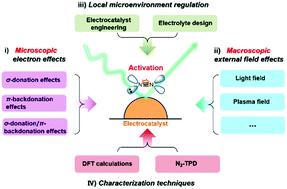当前位置:
X-MOL 学术
›
Energy Environ. Sci.
›
论文详情
Our official English website, www.x-mol.net, welcomes your feedback! (Note: you will need to create a separate account there.)
Strategies to activate inert nitrogen molecules for efficient ammonia electrosynthesis: current status, challenges, and perspectives
Energy & Environmental Science ( IF 32.5 ) Pub Date : 2022-05-10 , DOI: 10.1039/d2ee00358a Yongwen Ren , Chang Yu , Xinyi Tan , Qianbing Wei , Zhao Wang , Lin Ni , Linshan Wang , Jieshan Qiu
Energy & Environmental Science ( IF 32.5 ) Pub Date : 2022-05-10 , DOI: 10.1039/d2ee00358a Yongwen Ren , Chang Yu , Xinyi Tan , Qianbing Wei , Zhao Wang , Lin Ni , Linshan Wang , Jieshan Qiu

|
The electrocatalytic N2 reduction reaction (NRR) offers an alternative to the traditional Haber–Bosch (H–B) process for the synthesis of ammonia (NH3) and has received a surge of interest recently. However, as the prerequisite step for an efficient NRR, the N2 activation process over an electrocatalyst is rather difficult to be realized under mild conditions due to the thermodynamic stability and chemical inertness of the N2 molecule, which greatly limits the selectivity and activity of the NRR process, as well as the development of this renewable synthesis route for NH3. To date, a variety of electrocatalysts have been developed for effective N2 activation in the past five years, although the presented activation abilities for N2 molecules remain unsatisfactory even on the laboratory scale, and the corresponding design concepts/principles are still at the trial-and-error stage. Instead of focusing on labeling and classifying NRR electrocatalysts that have been extensively reviewed elsewhere, we herein present a timely and comprehensive review of emerging strategies to activate the inert N2 molecule for NH3 electrosynthesis at the microscopic and macroscopic level on the basis of an in-depth understanding of the physicochemical properties and microelectronic structure of the N2 molecule. We initially analyze the physicochemical properties and the microelectronic structure of the N2 molecule from the perspective of molecular orbital theory. On the basis of this, we then emphasize the microscopic electronic effects of electrocatalysts for enhancing N2 activation at length, typically covering σ-donation, π-backdonation, and σ-donation/π-backdonation effects, along with the design concepts/principles of electrocatalysts. Subsequently, the driving forces of macroscopic external fields (such as light, plasma, etc.) and the local microenvironment regulation-induced built-in electrostatic fields for assisting N2 activation are introduced. In addition, the methodologies for studying the N2 activation process over electrocatalyst surfaces are also presented from theoretical and experimental perspectives. Finally, we look at the future research directions and opportunities for improving N2 activation and stimulating the practical application of NRR technology, covering electrocatalyst engineering, process intensification, and device architecture.
中文翻译:

激活惰性氮分子以实现高效氨电合成的策略:现状、挑战和前景
电催化 N 2还原反应 (NRR) 为合成氨 (NH 3 ) 的传统 Haber-Bosch (H-B) 工艺提供了一种替代方法,并且最近受到了极大的关注。然而,作为高效NRR的先决条件,由于N 2 分子的热力学稳定性和化学惰性,电催化剂上的N 2活化过程在温和条件下难以实现,这极大地限制了N 2分子的选择性和活性。 NRR 工艺,以及这种可再生的 NH 3合成路线的开发。迄今为止,已经开发了多种电催化剂来实现有效的 N 2在过去的五年中,尽管N 2分子的活化能力即使在实验室规模上仍不能令人满意,并且相应的设计概念/原理仍处于试错阶段。我们没有专注于标记和分类已在其他地方广泛审查过的 NRR 电催化剂,而是在本文中及时全面地回顾了在微观和宏观水平上激活惰性 N 2分子用于 NH 3电合成的新兴策略。 -深入了解N 2的物理化学性质和微电子结构分子。我们初步从分子轨道理论的角度分析了N 2分子的物理化学性质和微电子结构。在此基础上,我们随后强调了电催化剂的微观电子效应以增强 N 2活化,通常包括 σ-donation、π-backdonation 和 σ-donation/π-backdonation 效应,以及设计概念/原理的电催化剂。随后,介绍了宏观外场(如光、等离子体等)的驱动力和局部微环境调控诱导的内建静电场辅助N 2活化。此外,研究 N 2的方法还从理论和实验的角度介绍了电催化剂表面的活化过程。最后,我们展望了改进 N 2活化和激发 NRR 技术实际应用的未来研究方向和机遇,涵盖电催化剂工程、工艺强化和器件架构。
更新日期:2022-05-10
中文翻译:

激活惰性氮分子以实现高效氨电合成的策略:现状、挑战和前景
电催化 N 2还原反应 (NRR) 为合成氨 (NH 3 ) 的传统 Haber-Bosch (H-B) 工艺提供了一种替代方法,并且最近受到了极大的关注。然而,作为高效NRR的先决条件,由于N 2 分子的热力学稳定性和化学惰性,电催化剂上的N 2活化过程在温和条件下难以实现,这极大地限制了N 2分子的选择性和活性。 NRR 工艺,以及这种可再生的 NH 3合成路线的开发。迄今为止,已经开发了多种电催化剂来实现有效的 N 2在过去的五年中,尽管N 2分子的活化能力即使在实验室规模上仍不能令人满意,并且相应的设计概念/原理仍处于试错阶段。我们没有专注于标记和分类已在其他地方广泛审查过的 NRR 电催化剂,而是在本文中及时全面地回顾了在微观和宏观水平上激活惰性 N 2分子用于 NH 3电合成的新兴策略。 -深入了解N 2的物理化学性质和微电子结构分子。我们初步从分子轨道理论的角度分析了N 2分子的物理化学性质和微电子结构。在此基础上,我们随后强调了电催化剂的微观电子效应以增强 N 2活化,通常包括 σ-donation、π-backdonation 和 σ-donation/π-backdonation 效应,以及设计概念/原理的电催化剂。随后,介绍了宏观外场(如光、等离子体等)的驱动力和局部微环境调控诱导的内建静电场辅助N 2活化。此外,研究 N 2的方法还从理论和实验的角度介绍了电催化剂表面的活化过程。最后,我们展望了改进 N 2活化和激发 NRR 技术实际应用的未来研究方向和机遇,涵盖电催化剂工程、工艺强化和器件架构。

























 京公网安备 11010802027423号
京公网安备 11010802027423号